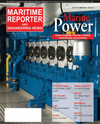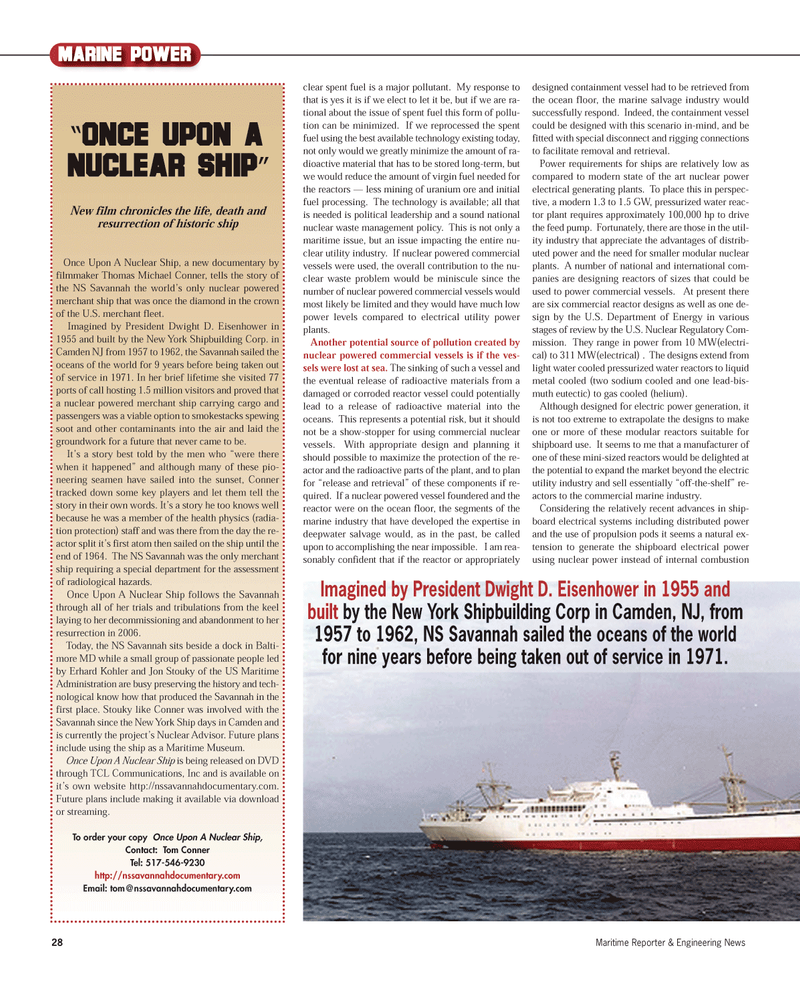
Page 28: of Maritime Reporter Magazine (September 2012)
Marine Propulsion Annual
Read this page in Pdf, Flash or Html5 edition of September 2012 Maritime Reporter Magazine
28Maritime Reporter & Engineering News Marine Powerclear spent fuel is a major pollutant. My response tothat is yes it is if we elect to let it be, but if we are ra- tional about the issue of spent fuel this form of pollu-tion can be minimized. If we reprocessed the spentfuel using the best available technology existing today, not only would we greatly minimize the amount of ra- dioactive material that has to be stored long-term, but we would reduce the amount of virgin fuel needed for the reactors ? less mining of uranium ore and initialfuel processing. The technology is available; all that is needed is political leadership and a sound nationalnuclear waste management policy. This is not only a maritime issue, but an issue impacting the entire nu- clear utility industry. If nuclear powered commercial vessels were used, the overall contribution to the nu- clear waste problem would be miniscule since the number of nuclear powered commercial vessels would most likely be limited and they would have much low power levels compared to electrical utility power plants. Another potential source of pollution created by nuclear powered commercial vessels is if the ves- sels were lost at sea. The sinking of such a vessel and the eventual release of radioactive materials from a damaged or corroded reactor vessel could potentially lead to a release of radioactive material into the oceans. This represents a potential risk, but it should not be a show-stopper for using commercial nuclear vessels. With appropriate design and planning it should possible to maximize the protection of the re-actor and the radioactive parts of the plant, and to plan for ?release and retrieval? of these components if re- quired. If a nuclear powered vessel foundered and the reactor were on the ocean floor, the segments of the marine industry that have developed the expertise in deepwater salvage would, as in the past, be called upon to accomplishing the near impossible. I am rea-sonably confident that if the reactor or appropriately designed containment vessel had to be retrieved from the ocean floor, the marine salvage industry would successfully respond. Indeed, the containment vessel could be designed with this scenario in-mind, and befitted with special disconnect and rigging connections to facilitate removal and retrieval. Power requirements for ships are relatively low as compared to modern state of the art nuclear power electrical generating plants. To place this in perspec- tive, a modern 1.3 to 1.5 GW, pressurized water reac- tor plant requires approximately 100,000 hp to drive the feed pump. Fortunately, there are those in the util- ity industry that appreciate the advantages of distrib- uted power and the need for smaller modular nuclear plants. A number of national and international com- panies are designing reactors of sizes that could beused to power commercial vessels. At present there are six commercial reactor designs as well as one de-sign by the U.S. Department of Energy in various stages of review by the U.S. Nuclear Regulatory Com- mission. They range in power from 10 MW(electri- cal) to 311 MW(electrical) . The designs extend from light water cooled pressurized water reactors to liquid metal cooled (two sodium cooled and one lead-bis- muth eutectic) to gas cooled (helium). Although designed for electric power generation, it is not too extreme to extrapolate the designs to make one or more of these modular reactors suitable forshipboard use. It seems to me that a manufacturer of one of these mini-sized reactors would be delighted at the potential to expand the market beyond the electric utility industry and sell essentially ?off-the-shelf? re- actors to the commercial marine industry. Considering the relatively recent advances in ship- board electrical systems including distributed power and the use of propulsion pods it seems a natural ex- tension to generate the shipboard electrical power using nuclear power instead of internal combustion ?Once Upon ANuclear Ship?New film chronicles the life, death and resurrection of historic ship Once Upon A Nuclear Ship, a new documentary by filmmaker Thomas Michael Conner, tells the story of the NS Savannah the world?s only nuclear powered merchant ship that was once the diamond in the crown of the U.S. merchant fleet. Imagined by President Dwight D. Eisenhower in 1955 and built by the New York Shipbuilding Corp. in Camden NJ from 1957 to 1962, the Savannah sailed the oceans of the world for 9 years before being taken out of service in 1971. In her brief lifetime she visited 77ports of call hosting 1.5 million visitors and proved that a nuclear powered merchant ship carrying cargo and passengers was a viable option to smokestacks spewing soot and other contaminants into the air and laid thegroundwork for a future that never came to be. It?s a story best told by the men who ?were there when it happened? and although many of these pio- neering seamen have sailed into the sunset, Conner tracked down some key players and let them tell the story in their own words. It?s a story he too knows well because he was a member of the health physics (radia- tion protection) staff and was there from the day the re- actor split it?s first atom then sailed on the ship until the end of 1964. The NS Savannah was the only merchant ship requiring a special department for the assessmentof radiological hazards.Once Upon A Nuclear Ship follows the Savannah through all of her trials and tribulations from the keel laying to her decommissioning and abandonment to herresurrection in 2006. Today, the NS Savannah sits beside a dock in Balti- more MD while a small group of passionate people ledby Erhard Kohler and Jon Stouky of the US Maritime Administration are busy preserving the history and tech- nological know how that produced the Savannah in the first place. Stouky like Conner was involved with the Savannah since the New York Ship days in Camden and is currently the project?s Nuclear Advisor. Future plans include using the ship as a Maritime Museum.Once Upon A Nuclear Ship is being released on DVD through TCL Communications, Inc and is available on it?s own website http://nssavannahdocumentary.com. Future plans include making it available via download or streaming.To order your copy Once Upon A Nuclear Ship, Contact: Tom Conner Tel: 517-546-9230 http://nssavannahdocumentary.com Email: [email protected] Imagined by President Dwight D. Eisenhower in 1955and built by the New York Shipbuilding Corp in Camden, NJ, from 1957 to 1962, NS Savannah sailed the oceans of the worldfor nine years before being taken out of service in 1971. MR#9 (26-33):MR Template 9/11/2012 1:54 PM Page 28

 27
27

 29
29
